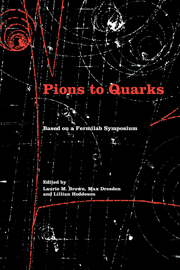Book contents
- Frontmatter
- Contents
- List of contributors
- Foreword by Leon M. Lederman
- Editors' acknowledgments
- Photographs of the symposium
- List of abbreviations
- List of notation
- I Introduction
- II Particle discoveries in cosmic rays
- III High-energy nuclear physics
- IV The new laboratory
- V The strange particles
- VI Weak interactions
- VII Weak interactions and parity nonconservation
- VIII The particle physics community
- IX Theories of hadrons
- X Personal overviews
- 45 Scientific impact of the first decade of the Rochester conferences (1950–1960)
- 46 Some reflections on the history of particle physics in the 1950s
- 47 Progress in elementary particle theory, 1950–1964
- Name index
- Subject index
46 - Some reflections on the history of particle physics in the 1950s
Published online by Cambridge University Press: 07 May 2010
- Frontmatter
- Contents
- List of contributors
- Foreword by Leon M. Lederman
- Editors' acknowledgments
- Photographs of the symposium
- List of abbreviations
- List of notation
- I Introduction
- II Particle discoveries in cosmic rays
- III High-energy nuclear physics
- IV The new laboratory
- V The strange particles
- VI Weak interactions
- VII Weak interactions and parity nonconservation
- VIII The particle physics community
- IX Theories of hadrons
- X Personal overviews
- 45 Scientific impact of the first decade of the Rochester conferences (1950–1960)
- 46 Some reflections on the history of particle physics in the 1950s
- 47 Progress in elementary particle theory, 1950–1964
- Name index
- Subject index
Summary
Introduction
Even a superficial comparison of the twelfth Solvay conference on physics, held in Brussels in October 1961 to discuss the quantum theory of fields, with the eighth Solvay conference, held in September 1948 to discuss elementary particles, highlights the dramatic changes in particle physics that had taken place in the decade of the 1950s.
The rapporteurs at the later conference were Richard Feynmen, Murray Gell-Mann, Marvin L. Goldberger, Walter Heitler, Gunnar Källen, Stanley Mandelstam, Abraham Pais, and Hideki Yukawa, all of whom (except for Heitler and Yukawa) received their graduate training in the 1940s. The list of invited members included a large number of younger theoreticians: Geoffrey Chew, Marcello Cini, Freeman Dyson, Tsung Dao Lee, Francis Low, Harry Lehmann, Yoichiro Nambu, Abdus Salam, Julian Schwinger, Leon Van Hove, Arthur Wightman, and Chen Ning Yang. This was in marked contrast with the 1948 conference (organized in the fall of 1947, and scheduled to be held in April 1948). There, some thirty-nine physicists were invited – the youngest being Homi J. Bhabha, who was thirty-eight at the time. There were few Americans on the invited list, and all these were émigrés (besides Albert Einstein, only Hans Bethe, Felix Bloch, Enrico Fermi, Bruno Rossi, and Edward Teller), because the resources of the Solvay Institute could not cover travel expenses from the United States. Everyone invited was a member of the prewar élite – among the theoreticians were Niels Bohr, Paul A. M. Dirac, Hans A. Kramers, Oscar Klein, Wolfgang Pauli, Rudolph Peierls, and Erwin Schrödinger.
- Type
- Chapter
- Information
- Pions to QuarksParticle Physics in the 1950s, pp. 668 - 693Publisher: Cambridge University PressPrint publication year: 1989
- 14
- Cited by



